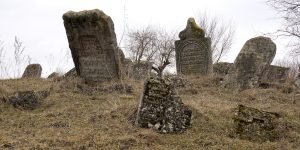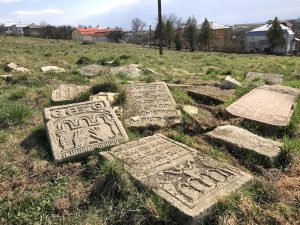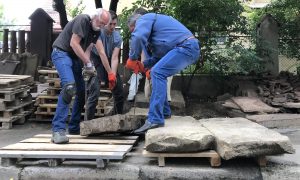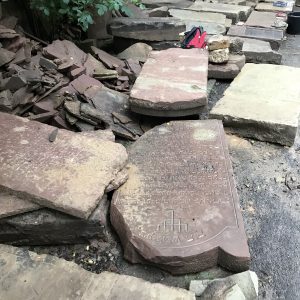![]() Ця сторінка також доступна українською.
Ця сторінка також доступна українською.
Introduction
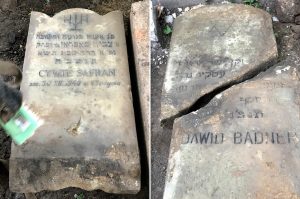
Intact and broken Jewish headstones unearthed during recovery work on vul. Barvinok in Lviv. Photos © RJH.
This page summarizes and tabulates the mechanical/physical properties of several types of stone materials which were historically used for the production of Jewish headstones (matzevot) erected in pre-war cemeteries in what is now western Ukraine. The data presented here is intended to support planning for and conducting headstone recovery projects (to return headstones displaced during periods of German and/or Soviet occupation to their cemeteries of origin) and also the guide page on headstone conservation projects on this website. Much of the data presented here is derived from published references on stone conservation; the specific sources used here are indicated in the table and listed at the bottom of this page, along with an explanation of some of the technical terms. As noted on the guide page, stone conservation is specialized work requiring training and experience to avoid doing more harm than good over the long term; that is also true for the interpretation and use of the material characteristics tabulated here.
Jewish headstones in western Ukraine were made from natural stone types which served both structural and decorative purposes and were sourced from local or regional quarries. Natural stone is a mixture of heterogenous materials exhibiting variable grain and often layers which can cause significant differences in characteristics when evaluated in different directions across a cut slab. Several of the qualities which facilitate the sawing, dressing, and carving of typical headstone materials also make the stone less durable in weather over decades and centuries. Most of the basic mechanical properties of natural stone change with absorbed moisture and with extended weathering as well. The stone properties data values presented here are specified and measured by the dimension stone industries for prepared newly-cut stone intended for the building trades, and may poorly represent a 200-year-old headstone in need of conservation. Experimental test methods for assessing the properties of weathered stone exist, though some methods are destructive and thus unsuitable for heritage preservation work.
Common Stone Types in Pre-War Matzevot in Western Ukraine
Nearly all of the headstones surviving in pre-war Jewish cemeteries in western Ukraine are made from sedimentary rock (e.g. limestone and sandstone), though there are a few extant headstones and memorial plaques made from other stone types, including igneous rock (e.g. granite), and metamorphic rock (e.g marble), as well as man-made materials such as concrete. Only the most frequently-found natural stone types are described here:
LIMESTONE: By far the most common material in Jewish headstones found in cemeteries and recovery projects is limestone. There are numerous types of limestone with a wide range of physical characteristics; many of those types are found in western Ukraine. Limestone is a clastic carbonate material, composed primarily of grains and/or fragments of calcite or calcium carbonate derived from marine organisms (fossil shells and bones) combined with smaller amounts of quartz, sand, clay, or other substances. The constituents of limestone may give cut stone a white to grey color in almost any shade, with large or fine grain. Some stones have visible streaks and stronger color hues; reddish streaks are present where iron oxide is present.
Limestone historically selected for headstone use typically exhibits lower visual and performance variations within and between sedimentary layers, but the range of variation of physical properties is quite broad based on the percentage of calcite or calcium carbonate content and on the density of the stone. Limestone, like sandstone and other sedimentary stones, exhibits marked anisotropic performance variation perpendicular to rift planes, i.e. the original deposition layers from which the stone was formed. For simplicity in applying dimensional stone data in the building trades, limestone is arbitrarily divided into three density categories (I, II, and III); the low-density category I is a useful material in many building applications but is not durable enough for headstone use.
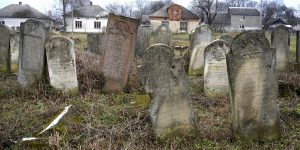
A pink sandstone example among a variety of other headstone materials in the new Jewish cemetery
of Zbarazh (Ternopil oblast). Photo © RJH.
SANDSTONE: Less common as a material in Jewish headstones in western Ukraine, sandstone is nonetheless still significantly present, and with somewhat different characteristics than limestone. Sandstone is a clastic material primarily based on crystalline quartz (silicon dioxide) having intrinsic hardness significantly greater than the constituents of limestone. Most sandstone types in Ukraine are relatively easy to work into architectural and decorative forms, and some have fine-grained texture which enhances their characteristics, but in general the durability of sandstone is quite variable. As a sedimentary rock, sandstone exhibits visual and performance variations within and between layers of different thicknesses as they formed through sedimentation and cementation. Bedding and lamination (thicker and thinner layers) may leave planes of weakness within headstones which can weather and lead to plane separation and destruction.
Sandstone historically used to make headstones in western Ukraine may be any of several colors, particularly tan, grey, and yellow. Quarries along the Seret and Hnizna rivers near Terebovlia (Ternopil oblast) have provided sandstone for headstone and memorial use across historical Galicia and beyond for several centuries; these sites are also the source of a fine grey-pink or red-brown sandstone which was especially prized for 20th-century grave markers and appears in many pre-war Jewish cemeteries as well as monuments of all types across western Ukraine and eastern Poland. Production of these sandstones continues in the region today. Some headstones made from pink or red sandstone show a pronounced tendency to split along rift planes, i.e. a significant weakness in bending across the major axes of the stone and shear in parallel to those axes.
GRANITE: Although it was much less commonly used for headstones in Jewish cemeteries in the past, the durability of granite (and granite-like rock materials) led to a relatively high survival rate of matzevot at burial sites and in recovery projects. As its name implies, granite is a coarse-grained igneous rock, formed from slowly-cooling silica-rich magma containing quartz and feldspar, usually with some mica. Together with its graininess, its well-known hardness and toughness historically made granite difficult to work into fine features for headstone epitaphs and symbolic shapes without specialized tools and considerable skill, but the significant weather resistance of the material likely made it an attractive alternative to limestone and sandstone. Colors seen in prewar Jewish headstones include light to dark grey plus grey-green and especially pink, with the coarse grain and sparkling mica changing the appearance of the stone when observed at close distance.
Note that stone types other than granite are routinely categorized with granite because of their properties, regardless of their geological formation and composition. Materials such as gabbro (an igneous rock which appears dark, even black) and gneiss (an attractive banded metamorphic rock) are examples which normally are categorized with granite.
Stone Data

Jewish headstones made of sandstone which have delaminated from stress after misuse as roadbed
under vul. Barvinok in Lviv. Photo © RJH.
As noted above, the physical properties data values tabulated below are for newly-cut dry stone prepared for the building trades, derived from the sources indicated and listed at the bottom of this page. The terminology used to identify each of the properties is defined in the section which follows. The values are converted and tabulated in metric units, as averages or in ranges because natural stone varies by geological and geographic origin, and even within quarries; further, for sedimentary stone, the most common type historically used in Jewish headstones in western Ukraine, “there are remarkable differences in strength and behavior of stone specimens loaded parallel to the bedding […] and perpendicular to it in both dry and wet conditions”. [5] Additional limitations in applying the values to practical problems of headstone conservation arise from important differences in test article size, shape, loading, etc. vs real-world applications. These values are thus presented as guidance, with advice to exercise normal engineering caution.
Note that values for some important physical properties of stone are not yet tabulated here, including measures of impact strength and resistance to soluble salts, and the measures of hardness and abrasion resistance listed apply poorly to cemetery heritage work. Although these properties are very relevant to heritage projects involving stone conservation, we have not yet identified practical resources which document test methods and values which are suitable for cemetery preservation applications. The table will be updated and expanded if/when useful data is identified.
Physical Properties of Stone:
| Property | Standard | Units | Limestone I (*) | Limestone II | Limestone III | Sandstone | Granite | Refs |
|---|---|---|---|---|---|---|---|---|
| Standard | [ . . . . . . . . . . | ASTM C658 | . . . . . . . . . . ] | ASTM C616 | ASTM C615 | |||
| Density | ASTM C97 | kg/m^3 | 1760 ~ 2030 | 2160 ~ 2490 | 2560 ~ 2950 | 2160 ~ 2720 | 2400 ~ 3200 | [1] [9] |
| Specific Gravity | ASTM C97 | n/a | 1.76 ~ 2.03 | 2.16 ~ 2.49 | 2.56 ~ 2.95 | 2.16 ~ 2.72 | 2.40 ~ 3.20 | [1] [9] |
| Water Absorption by Weight | ASTM C97 | % | 12 ~ 29 | 7 ~ 15 | 3 ~ 10 | 3 ~ 10 | 0.02 ~ 0.40 | [1] |
| Compressive Strength | ASTM C170 | MPa | 12 ~ 30 | 28 ~ 60 | 55 ~ 150 | 30 ~ 100 | 35 ~ 200 | [1] [7] [9] |
| Flexural Strength | ASTM C880 | MPa | [ . . . . . . . . . . | 3 ~ 18 | . . . . . . . . . . ] | 5 ~ 15 | 5 ~ 30 | [1] |
| Modulus of Rupture | ASTM C99 | MPa | 3 ~4 | 3 ~ 5 | 5 ~ 7 | 2 ~ 8 | 7 ~ 20 | [1] |
| Tensile Strength | MPa | [ . . . . . . . . . . | 2 ~ 5 | . . . . . . . . . . ] | 2 ~ 7 | 4 ~ 7 | [3] [7] | |
| Shear Strength | MPa | [ . . . . . . . . . . | 6 ~ 12 | . . . . . . . . . . ] | 2 ~ 20 | 14 ~ 30 | [3] | |
| Scratch Hardness, Mohs Scale | n/a | [ . . . . . . . . . . | 2 ~ 4 | . . . . . . . . . . ] | 2 ~ 7 | 5 ~ 8 | [6] [9] | |
| Modulus of Elasticity | ASTM C1352 | GPa | [ . . . . . . . . . . | 4 ~ 50 | . . . . . . . . . . ] | 7 ~ 50 | 14 ~ 69 | [1] [7] [9] |
| Abrasion Resistance, Ha | ASTM C241 | n/a | [ . . . . . . . . . . | 3 ~ 33 | . . . . . . . . . . ] | 3 ~ 12 | 20 ~ 90 | [1] |
| Coefficient of Thermal Expansion | EN 14581 | 10E-6/K | [ . . . . . . . . . . | 4 ~ 12 | . . . . . . . . . . ] | 8 ~ 15 | 5 ~ 11 | [1] [3] [8] [9] [10] |
| Thermal Conductivity | W/mK | [ . . . . . . . . . . | 1.2 ~ 2.6 | . . . . . . . . . . ] | 1.8 ~ 4 | 1.7 ~ 4 | [2] [8] |
(*) Limestone I (low density) is included here for completeness but is unlikely to appear in any headstones in western Ukraine.
Explanation of Terms
The terms used here for characteristics and performance of stone generally follow the definitions of ASTM standard C119, as summarized in Chapter 4 (Stone Testing) of the Dimension Stone Design Manual, Version VIII, published by the Natural Stone Institute [1], and their Technical Note “Dimension Stone Test Methods, Guides, and Standards” [4]; the ASTM terms and test methods exist in comparable documents published by several European national standards organizations, but an international standard embracing all of the methods does not yet exist. Refer to the ASTM standards listed in the data table above for more detailed information.
Density: Density is the mass or weight of stone per unit volume, typically expressed as kilograms per cubic meter. The measure of density is significant in stone evaluation, as there is a strong correlation between stone density and strength. In standardized testing, density is often evaluated with water absorption because water affects the weight of stone and because porosity is a secondary indicator of the structure and strength of stone.
Specific Gravity: A unitless ratio of the density of a material to the density of water (1000kg/m^3); this is a derived quantity, but a practical value for stone recovery and conservation projects.
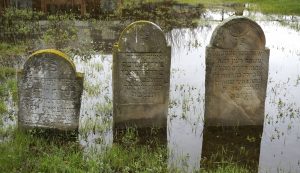
Water absorption is impossible to prevent in the Jewish cemetery of Sasovo (Zakarpattia oblast). Photo © RJH.
Water Absorption by Weight: A simplified measure of stone porosity which strongly indicates the material’s susceptibility to damage during freeze cycles. The test compares the weight of a stone sample after soaking in water for 48 hours to its dry weight before testing; the ratio is taken as a percentage.
Compressive Strength: The maximum steady compression (crushing) load a stone sample can bear before crumbling, compressive strength is expressed in units of pressure, e.g. Pascals (Pa, N/m^2, or kg/m-s^2); in English units, 1psi equals roughly 6900Pa. In testing, samples are typically cuboid and at least 50mm per edge. Testing may characterize both dry and wet stone, both parallel and perpendicular to the rift. Like actual stone in headstones, test samples with included defects perform significantly worse (are weaker) than uniform samples. This measure has applicability in headstone recovery work, including transport and temporary stacking and storage.
Flexural Strength: Also called bending strength, this measure is expressed in pressure units (Pa) like compressive strength. The test defined by ASTM C880 places a stone sample on supports near the ends and applies two equal loads at 1/4 length form each end, creating a constant bending moment between the loads so that weakness can be revealed at any point between. This measure has applicability in headstone recovery work, including transport and temporary stacking and storage.
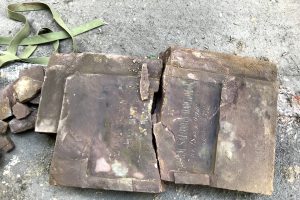
A 20th-century sandstone headstone fractured by lateral loads under vul. Barvinok in Lviv. Photo © RJH.
Modulus of Rupture: An alternate measure of flexural strength, likewise expressed in pressure units (Pa), the test per ASTM C99 supports the test sample at each end and applies a single load to the center of the suspended beam span, which concentrates the bending moment at that center. Note that “flexural strength” per ASTM C880 is now preferred in place of the older “modulus of rupture” per ASTM C99, though in the headstone application either test method could be useful because of the relatively thick slabs into which most headstones are cut; many intact headstones meet the C880 test guideline of length greater than 12 times thickness, but many (and most recovered fragments) do not. See the diagrams in reference [4] for a visual explanation of the tests.
Tensile Strength: The maximum steady pulling (stretching) load a stone sample can bear before breaking, expressed in pressure units (Pa). Because stone is typically much weaker in tension than in compression, flexural strength is heavily influenced by tensile strength, and stone monuments are usually designed to minimize or eliminate internal tension. Tensile strength also figures significantly in the ability of natural stone materials to withstand expansion of absorbed water during freeze-thaw cycles, as well as soluble salt damage. There is no standardized test for natural stone, but common tensile test methods can be adapted to evaluate stone samples.
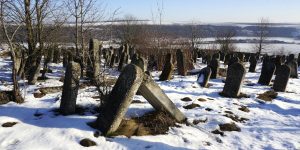
Two headstones lean on each other for support in the Jewish cemetery of Korolivka (Ternopil oblast). Photo © RJH.
Shear Strength: The maximum steady shear load a stone sample can withstand; shear stress produces a deformation in the material wherein parallel internal surfaces slide past one another resulting in a parallelogram shape. As for other strength measures, shear strength is expressed in pressure units (Pa). As some sedimentary stones show considerable weakness in shear parallel to the rift plane, this measure can be critical in headstone handling even though shear loading is uncommon in normal installation. There is no standardized test for natural stone, but common shear test methods for wood, adhesives, and other materials can be adapted to evaluate stone samples.
Scratch Hardness: The standard scratch hardness test for minerals (Mohs scale) applies rather poorly to natural stone materials because they are each formed from mixtures of several minerals and/or organic components having different inherent hardness. However, scratch testing is one way to differentiate limestone from sandstone in headstones as they are evaluated at burial sites, and also highlights surface disintegration and friability.
Modulus of Elasticity: A measure of the material stiffness of stone, expressed in units of pressure (Pa) like strength (see above). The test is set up similarly to that for flexural strength, measuring beam deflection under load instead of ultimate strength at failure. The stiffness of stone has relevance in repairs using pins and splints of different materials, and in anchors for memorial design.
Abrasion Resistance: A practical test which involves a cast iron drum lap rotating under pressure with an abrasive powder against a stone sample, with the sample weighed before and after the abrasion to evaluate the amount of stone removed. This test cannot be extrapolated to field use, but the results can be compared between stone types to understand general durability. Note that the outer material of weathered headstone is often substantially less resistant to abrasion that the stone core.
Coefficient of Thermal Expansion: Measures the unitless fractional change in the linear size of a material sample per degree of temperature (degree C or K in metric units). This value has relevance to headstone repairs pinned or anchored with dissimilar materials (e.g. metal pins) and to headstone resetting (and memorial monuments which incorporate relic headstones and fragments) constructed of man-made materials (e.g. concrete). There is a European Norm test for natural stone, but test methods for other solid materials can also be adapted.
Thermal Conductivity: A measure of the ability of stone to conduct heat; in modern building practice, this is often evaluated from the perspective of insulation as thermal resistivity, the reciprocal of conductivity. The units of conductivity (W/m-k) define the measure: the amount of heat which flows across a length of material at two different temperatures; the higher the conductivity value, the greater the flow of heat. This measure has relevance to memorial designs incorporating recovered headstones and subject to solar heating. There is no standardized test for natural stone, but limestone, sandstone, marble, and concrete have been heavily studied.
References

Postwar headstones in a variety of mostly man-made materials in the Jewish cemetery of Mukachevo (Zakarpattia oblast). Photo © RJH.
Both specific and general references applicable to stone mechanical properties are listed here. See the resources page on stone conservation on this website for a broader range of references applicable to aspects of heritage preservation projects for headstones and stone memorials.
[1] Dimension Stone Design Manual, Version VIII; Natural Stone Institute, 2016: Chapter 2 (Standards and Specifications); Chapter 4 (Stone Testing); Chapter 5 (Granite); Chapter 6 (Limestone); Chapter 8 (Quartz-Based Stone); Chapter 23 (Glossary of Stone Industry Terms). [2] R-Value for Natural Stone; Natural Stone Institute / Marble Institute of America; Technical Bulletin, Volume I, Issue 4, August 2004. [3] Selecting the Right Stone; Publication #M890230; Aberdeen Group, 1989. [4] Dimension Stone Test Methods, Guides, and Standards; Natural Stone Institute / Marble Institute of America; Technical Bulletin, Volume VII, Issue 1, June 2014. [5] Mechanical Properties of Natural Building Stone: Jordanian Building Limestone as an Example; Nart Mawloud Naghoj et al.; Jordan Journal of Earth and Environmental Sciences; Volume 3, Number 1, June 2010. [6] The Hardness of Rocks and Minerals; Bill Cordua; International Lapidary Association, 1998. Internet searches give additional unsourced data, including references 6a, 6b, 6c, 6d, 6e, 6f, 6g. [7] Moisture expansion as a deterioration factor for sandstone used in buildings; Joerg Ruedrich et al.; Environmental Earth Sciences; Vol. 63, August 2011, pp.1545~1564. [8] Thermal Properties of Rocks; Eugene C. Robertson; USGS Report 88-441, 1988. [9] Physical Properties of Building Stone; Eugene C. Robertson; in Conservation of Historic Stone Buildings and Monuments; National Academies Press, 1982, pp.62~86. [10] Coefficients of Thermal Expansion; The Engineering Toolbox; website, undated.
